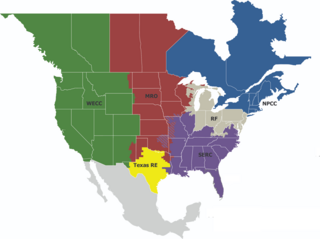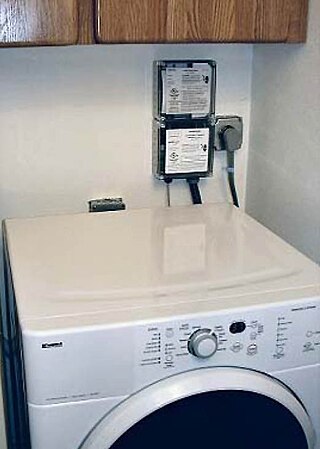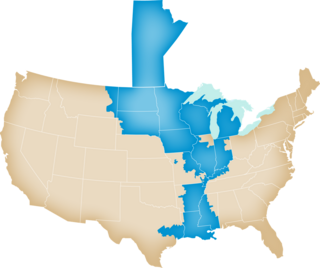
The Federal Energy Regulatory Commission (FERC) is an independent agency of the United States government that regulates the interstate transmission and wholesale sale of electricity and natural gas and regulates the prices of interstate transport of petroleum by pipeline. FERC also reviews proposals to build interstate natural gas pipelines, natural gas storage projects, and liquefied natural gas (LNG) terminals, in addition to licensing non-federal hydropower projects.

The North American Electric Reliability Corporation (NERC) is a nonprofit corporation based in Atlanta, Georgia, and formed on March 28, 2006, as the successor to the North American Electric Reliability Council. The original NERC was formed on June 1, 1968, by the electric utility industry to promote the reliability and adequacy of bulk power transmission in the electric utility systems of North America. NERC's mission states that it "is to assure the effective and efficient reduction of risks to the reliability and security of the grid".

A public utility company is an organization that maintains the infrastructure for a public service. Public utilities are subject to forms of public control and regulation ranging from local community-based groups to statewide government monopolies.
In a broad sense, an electricity market is a system that facilitates the exchange of electricity-related goods and services.

The electric power industry covers the generation, transmission, distribution and sale of electric power to the general public and industry. The commercial distribution of electric power started in 1882 when electricity was produced for electric lighting. In the 1880s and 1890s, growing economic and safety concerns lead to the regulation of the industry. What was once an expensive novelty limited to the most densely populated areas, reliable and economical electric power has become an essential aspect for normal operation of all elements of developed economies.
The Open Access Same-Time Information System (OASIS), is an Internet-based system for obtaining services related to electric power transmission in North America. It is the primary means by which high-voltage transmission lines are reserved for moving wholesale quantities of electricity. The OASIS concept was originally conceived with the Energy Policy Act of 1992, and formalized in 1996 through Federal Energy Regulatory Commission (FERC) Orders 888 and 889.

As one of the four power marketing administrations within the U.S. Department of Energy, the Western Area Power Administration (WAPA)'s role is to market wholesale hydropower generated at 57 hydroelectric federal dams operated by the Bureau of Reclamation, United States Army Corps of Engineers and the International Boundary and Water Commission. WAPA delivers this power through a more than 17,000-circuit-mile, high-voltage power transmission system to more than 700 preference power customers across the West. Those customers, in turn, provide retail electric service to more than 40 million consumers. WAPA is headquartered in the Denver, Colorado suburb of Lakewood, Colorado.

A regional transmission organization (RTO) in the United States is an electric power transmission system operator (TSO) that coordinates, controls, and monitors a multi-state electric grid. The transfer of electricity between states is considered interstate commerce, and electric grids spanning multiple states are therefore regulated by the Federal Energy Regulatory Commission (FERC). The voluntary creation of RTOs was initiated by FERC Order No. 2000, issued on December 20, 1999. The purpose of the RTO is to promote economic efficiency, reliability, and non-discriminatory practices while reducing government oversight.

Demand response is a change in the power consumption of an electric utility customer to better match the demand for power with the supply. Until the 21st century decrease in the cost of pumped storage and batteries, electric energy could not be easily stored, so utilities have traditionally matched demand and supply by throttling the production rate of their power plants, taking generating units on or off line, or importing power from other utilities. There are limits to what can be achieved on the supply side, because some generating units can take a long time to come up to full power, some units may be very expensive to operate, and demand can at times be greater than the capacity of all the available power plants put together. Demand response, a type of energy demand management, seeks to adjust in real-time the demand for power instead of adjusting the supply.
The Texas electricity market is deregulated, meaning that there is competition in the generation and distribution of electricity. Power generators in the Texas Interconnection, managed by the Electric Reliability Council of Texas, participate in an energy-only electricity market and are compensated only for the electricity they produce. The wholesale generation market was deregulated in 1995 and the distribution market in 1999, with Texas Senate Bill 7. This replaced the prior system in which power was generated and consumed locally by the same utility with one in which retail providers contracted with generators across the state.

Great River Energy is an electric transmission and generation cooperative in the U.S. state of Minnesota; it is the state's second largest electric utility, based on generating capacity, and the fifth largest generation and transmission cooperative in the U.S. in terms of assets. Great River Energy was formed in 1999 when Cooperative Power Association and United Power Association merged.

Southwest Power Pool (SPP) manages the electric grid and wholesale power market for the central United States. As a regional transmission organization, the nonprofit corporation is mandated by the Federal Energy Regulatory Commission to ensure reliable supplies of power, adequate transmission infrastructure and competitive wholesale electricity prices. Southwest Power Pool and its member companies coordinate the flow of electricity across approximately 60,000 miles of high-voltage transmission lines spanning 14 states. The company is headquartered in Little Rock, Arkansas.

The Midcontinent Independent System Operator, Inc., formerly named Midwest Independent Transmission System Operator, Inc. (MISO) is an Independent System Operator (ISO) and Regional Transmission Organization (RTO) providing open-access transmission service and monitoring the high-voltage transmission system in the Midwest United States and Manitoba, Canada and a southern United States region which includes much of Arkansas, Mississippi, and Louisiana. MISO also operates one of the world's largest real-time energy markets. The 15 states covered by MISO are: Arkansas, Illinois, Indiana, Iowa, Kentucky, Louisiana, Michigan, Minnesota, Mississippi, Missouri, Montana, North Dakota, South Dakota, Texas, and Wisconsin.

PJM Interconnection LLC (PJM) is a regional transmission organization (RTO) in the United States. It is part of the Eastern Interconnection grid operating an electric transmission system serving all or parts of Delaware, Illinois, Indiana, Kentucky, Maryland, Michigan, New Jersey, North Carolina, Ohio, Pennsylvania, Tennessee, Virginia, West Virginia, and the District of Columbia.
There is a large array of stakeholders that provide services through electricity generation, transmission, distribution and marketing for industrial, commercial, public and residential customers in the United States. It also includes many public institutions that regulate the sector. In 1996, there were 3,195 electric utilities in the United States, of which fewer than 1,000 were engaged in power generation. This leaves a large number of mostly smaller utilities engaged only in power distribution. There were also 65 power marketers. Of all utilities, 2,020 were publicly owned, 932 were rural electric cooperatives, and 243 were investor-owned utilities. The electricity transmission network is controlled by Independent System Operators or Regional Transmission Organizations, which are not-for-profit organizations that are obliged to provide indiscriminate access to various suppliers to promote competition.
Smart grid policy in the United States refers to legislation and other governmental orders influencing the development of smart grids in the United States.

The California Independent System Operator (CAISO) is a non-profit Independent System Operator (ISO) serving California. It oversees the operation of California's bulk electric power system, transmission lines, and electricity market generated and transmitted by its member utilities. CAISO is one of the largest ISOs in the world, delivering 300 million megawatt-hours of electricity each year and managing about 80% of California's electric flow.

The electrical power grid that powers Northern America is not a single grid, but is instead divided into multiple wide area synchronous grids. The Eastern Interconnection and the Western Interconnection are the largest. Three other regions include the Texas Interconnection, the Quebec Interconnection, and the Alaska Interconnection. Each region delivers power at a nominal 60 Hz frequency. The regions are not usually directly connected or synchronized to each other, but there exist some HVDC interconnectors. The Eastern and Western grids are connected via seven links that allow 1.32 GW to flow between them. A study by the National Renewable Energy Laboratory found that increasing these interconnections would save energy costs.
Electric grid security in the US refer to the activities that utilities, regulators, and other stakeholders play in securing the national electricity grid. The American electrical grid is going through one of the largest changes in its history, which is the move to smart grid technology. The smart grid allows energy customers and energy providers to more efficiently manage and generate electricity. Similar to other new technologies, the smart grid also introduces new concerns about security.

A regional entity (RE) in the North American power transmission grid is a regional organization representing all segments of the electric industry: electric utilities, federal agencies, independent power producers, power market operators, and end-users of the energy. North American Electric Reliability Corporation (NERC) delegates to REs authority to enforce reliability standards, collectively REs, together with NERC, are known as an "ERO Enterprise".












